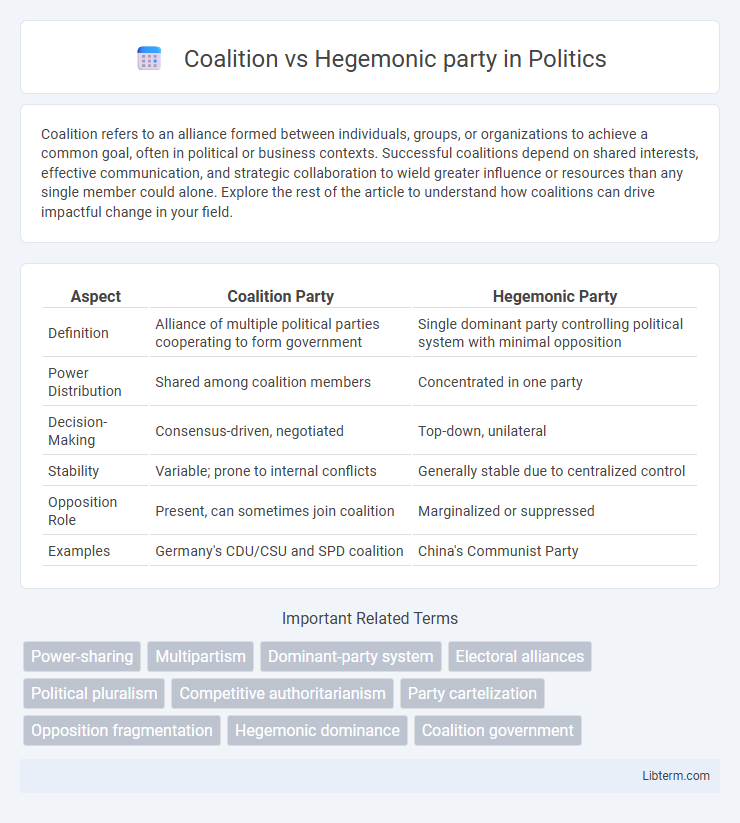Coalition refers to an alliance formed between individuals, groups, or organizations to achieve a common goal, often in political or business contexts. Successful coalitions depend on shared interests, effective communication, and strategic collaboration to wield greater influence or resources than any single member could alone. Explore the rest of the article to understand how coalitions can drive impactful change in your field.
Table of Comparison
| Aspect | Coalition Party | Hegemonic Party |
|---|---|---|
| Definition | Alliance of multiple political parties cooperating to form government | Single dominant party controlling political system with minimal opposition |
| Power Distribution | Shared among coalition members | Concentrated in one party |
| Decision-Making | Consensus-driven, negotiated | Top-down, unilateral |
| Stability | Variable; prone to internal conflicts | Generally stable due to centralized control |
| Opposition Role | Present, can sometimes join coalition | Marginalized or suppressed |
| Examples | Germany's CDU/CSU and SPD coalition | China's Communist Party |
Understanding Coalition and Hegemonic Party Systems
Coalition party systems involve multiple political parties collaborating to form a government, often seen in proportional representation democracies where no single party gains an outright majority. Hegemonic party systems are dominated by one political party that consistently controls political power, marginalizing opposition despite the presence of multiparty elections. Understanding these systems requires analyzing party dynamics, electoral rules, and the balance of political power within a given country's political landscape.
Historical Evolution of Coalition vs Hegemonic Parties
The historical evolution of coalition and hegemonic parties highlights their distinct pathways: coalition parties emerged as pragmatic alliances of multiple political groups to achieve majority rule, often seen in parliamentary democracies like post-war Germany and Italy. Hegemonic parties dominated political systems by maintaining prolonged single-party control, exemplified by the Institutional Revolutionary Party (PRI) in Mexico or the African National Congress (ANC) in South Africa, often blurring lines between state and party. Shifts in political landscapes, democratization, and electoral reforms have reshaped these party types, influencing governance, political stability, and policy continuity throughout the 20th and 21st centuries.
Structural Characteristics of Coalitions
Coalition parties are characterized by a collaborative structure where multiple political groups unite to form a governing body, typically reflecting diverse interests and ideologies. In contrast to hegemonic parties that dominate political power through centralized control, coalitions rely on negotiated agreements and power-sharing mechanisms to maintain stability. This structural complexity often results in flexible policy-making processes but can also lead to challenges in maintaining cohesion and decisiveness.
Defining Features of Hegemonic Parties
Hegemonic parties maintain long-term dominance by systematically controlling political institutions, manipulating electoral processes, and limiting opposition through legal and extralegal means. They emphasize centralized leadership, ideological unity, and extensive patronage networks to reinforce their authority and societal influence. Unlike coalition parties that rely on alliances among diverse groups, hegemonic parties consolidate power within a singular dominant organization.
Political Stability: Coalition vs Hegemony
Coalition governments often face political instability due to divergent party agendas and the necessity for compromise, which can lead to fragile alliances and frequent policy shifts. In contrast, hegemonic parties maintain stability through centralized control and a unified policy direction, minimizing internal conflicts and ensuring consistent governance. However, hegemonic dominance may suppress political pluralism, whereas coalitions reflect diverse representation but risk volatility.
Representation and Inclusivity in Both Systems
Coalition parties enhance representation by including multiple political groups, allowing diverse social and ideological interests to influence policymaking, which leads to greater inclusivity of minority voices. Hegemonic parties often concentrate power within a dominant group, potentially marginalizing opposition and limiting the spectrum of represented interests. While coalition systems foster pluralism and compromise, hegemonic parties prioritize stability and uniform policy direction, often at the expense of broad inclusiveness.
Policy-making Dynamics in Coalition and Hegemonic Parties
Coalition parties often experience complex policy-making dynamics due to the need to reconcile diverse interests and negotiate among multiple factions, leading to compromises and incremental policy outcomes. In contrast, hegemonic parties wield centralized control, enabling swift decision-making and the implementation of cohesive, unified policy agendas without extensive negotiation. The policy process in coalition governments emphasizes consensus-building and power-sharing, whereas hegemonic parties prioritize maintaining dominance through top-down directives and streamlined governance.
Challenges and Criticisms of Each System
Coalition parties often face challenges such as policy gridlock due to differing agendas among member parties, leading to unstable governance and difficulty in passing legislation. Hegemonic parties encounter criticisms related to diminished political competition, risks of authoritarianism, and limited checks and balances, which may undermine democratic processes. Both systems struggle with maintaining public trust and effective representation amid these structural limitations.
Global Case Studies: Coalitions and Hegemonic Parties
Coalitions are prevalent in parliamentary systems like India, where multiple parties form alliances to secure a majority, facilitating diverse representation but often leading to policy compromises. Hegemonic parties dominate political landscapes, as seen in South Africa's African National Congress (ANC), maintaining power through broad-based support and control over institutions, yet facing challenges of internal factionalism and opposition marginalization. Global case studies reveal that coalition governments often enhance democratic pluralism, whereas hegemonic parties can ensure stability but risk entrenching authoritarian tendencies.
Future Trends: Coalition Governance vs Party Hegemony
Future trends in coalition governance suggest increased complexity as multi-party systems adapt to growing voter diversity and issue specialization, promoting power-sharing and negotiation over unilateral decision-making. Party hegemony, while offering stability and streamlined policy implementation, risks stagnation and decreased public trust amid evolving demands for inclusivity and transparency. The balance between coalition diplomacy and hegemonic authority will shape democratic resilience and policy responsiveness in the coming decades.
Coalition Infographic

 libterm.com
libterm.com